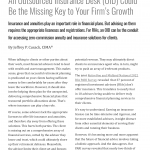Eliminating Commissions Opens Door to Further Innovation
No-load annuities appear to be gaining traction among IARs of RIA firms, and journalist Ben Mattlin takes a stab at why in an article for Financial Advisor Magazine. Innovations among a class of next-gen, no-load annuities have reduced cost, introduced simplicity, offered liquidity, made them easier of understand and use, integrated them deeper into the advisor’s portfolio management software, and driven real client value.
The innovation began when commissions were eliminated from these products. Getting rid of commissions removed the conflict of interest, since advisors are no longer incented to simply sell regardless of what may be in the client’s best interest. Without a commission, lock-up periods are unnecessary. Removing commissions also allows RIAs, who are fiduciaries, to recommend them in client portfolios since there is no longer a conflict of interest.
Solving the Billing Problem
Ostensibly, RIAs are able to bill clients for the management of these annuities directly which then couples the fortunes of the advisor to that of their clients. In this arrangement, the advisor is incented to make the very best decisions for their clients, since those decisions ultimately impact her or him directly. But until recently, billing from fee-based, non-qualified annuities triggered a taxable event for the annuity owners, which represented yet another barrier to adoption.
A recent private letter ruling for fee-based annuities from the IRS has granted relief to owners of these annuities (from certain insurance companies) who choose to compensate their advisor directly from the investment. Will this spark extraordinary growth in adoption of no-load annuities among RIAs?
The Need for Fintech Innovation
RetireOne CEO David Stone says, “There needs to be more innovation to significantly grow RIA adoption, and the insurance industry has been slow to go there.” Stone believes annuities need to be better integrated as part of overall retirement planning, and that will require more technological advances, and new ways of thinking about how the insurance protections may be uncoupled from the investments themselves.



